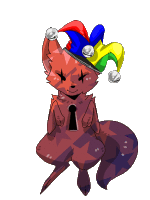Ciel Oseaux
• Singular - Ciel Oseau • • • Plural - Ciel Oseaux •
• (see - elle) (Oay - zoo) •
• (see - elle) (Oay - zoo) •
What is a Ciel Oseau? - - - - -
Literally meaning "sky birds" in French, Ciel Oseaux are creatures of the sky. They spend the majority of their time collecting the small gadgets and gizmos that they hoard, and stuffing them into clouds. How is that possible? Ciel Oseaux do not live on earth, the clouds in their world are a lot thicker and not as easy to go thought because of major atmospheric pressure. The things they hid in clouds are often lost because the Ceil Oseau cannot go into them. They still, however, feel attached to these things, so they are often found dragging clouds around with them that contain their belongings.
The most notable features on the Ciel Oseau is their ears and wings. Being closer related to flying squirrels than to sugar gilders, Ciel Oseaux have a greater lift and less drag. Because they are almost 1/2 blind, they use their ears to help them catch sounds that bounce off objects (normally clouds) around them, like bats do. Even though they do have impaired vision, they still wear goggles almost all the time because their eyes are very sensitive. If they didn't keep their goggles on while they were in the sky, they would be blinded in a matter of minuets.
Mating and Social Habits - - - - -
Ciel Oseaux are very social creatures. They are most commonly found in groups raging in sizes form 10 - 40. Ciel Oseaux depend on each other greatly for food and even shelter in some cases. Each group of Ciel Oseaux has at least 5-20 gathers, depending on the size. These gathers search for food on the ground, while the rest of the group stays in the clouds. Because of how many predators Ciel Oseaux have, and how dangerous it is to go on the ground, those that gather are often in the highest ranks. There aren't any other ranks other than gather, for the most part Ciel Oseaux look at every creature as an equal.
Ciel Oseaux are a bit different in their mating habits, straying from just about all norms that humans know. The average number of Ciel Oseaux involved in a relationship is about 3, though it can be more or less. Every Ciel Oseaux that is in the relationship will produce offspring(s) with every member all at the same time. So instead of there being only 2 blood related parents, there can be up to 5. The offspring will get traits from every parents, the most common traits will have a more likely chance at being passed down, though.
Their parings don't know many limits, you could have 3 males and 2 females in a relationship, or 4 females and one male, even all females or all males. Ciel Oseaux don't have defined genders, and have both male and female parts, but most Ciel Oseaux tend to lean toward one gender or the other. The gender that they do pick is what they identify with, though some chose to be seen as not male or female, or sometimes be seen as both. In that case, they are often referred to as "they" and "them".
Rarities - - - - - - -
Common Ciel Oseaux - No edits to hair/fur, lighter underbelly, natural base coat, spots any were on body, or unnatural accents.
Uncommon Ciel Oseaux - Horns, smaller hair/fur edits, darker underbelly, unnatural base coat, fluff on chin, bi-colored eyes, or dark Scleral.
Rare Ciel Oseaux - Custom lines, longer hair (past chest fur), Major fur edits, no markings (plain), albino, Ear/tail edits, or no wings.
Other Information - - - - - -
Colors - On average they have a natural base coat with either natural or unnatural colored markings.
Sexuality - Ciel Oseaux often don't identify as being strictly homosexual or straight, most fall into the bisexual and pansexual rage. Though, those that are (or want to be) in a relationship with only members of their same or opposite gender, then they identify as homosexual or straight.
Genders and pronouns - Can be seen as any gender they want to, but still do have both male and female parts. They can use any pronouns that humans use, but the most common are "She", "He", and "Them".
Number of Pups per Litter - The average number of pups in a liter is 1, but it is possible to have 2 pups.


















